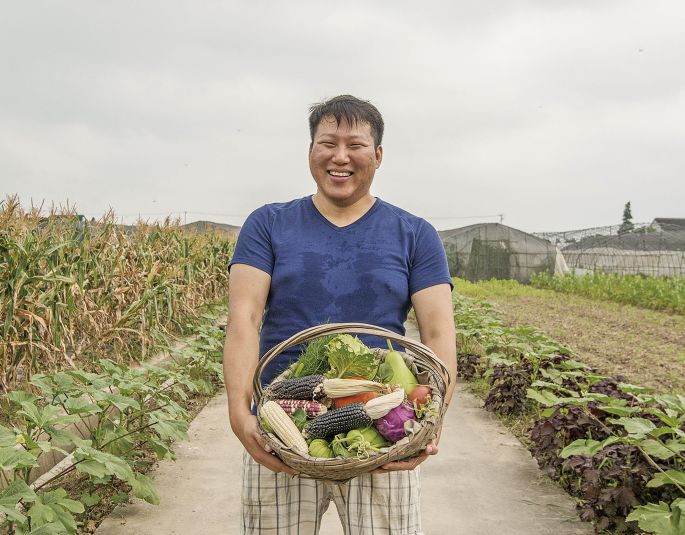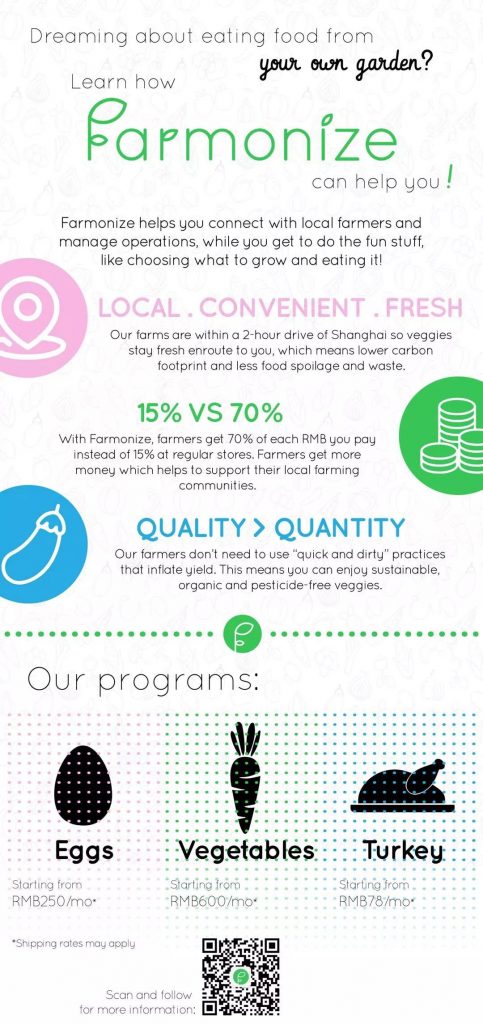For your chance to win, head over to our WeChat account by scanning the QR Code below and fill in the blanks: When I make _____, I always add _____ to make it taste even better.


We’ll choose 3 lucky winners next week to each get a carton of ethically raised turkey eggs that would be of good use at your next brunch. Also, Sherpa’s followers can get a 10% discount on all Farmonize subscriptions (valid until May 2).
This week’s Winning Wednesday is slightly different from the previous competitions you’ve scrolled through. The reason being – we want to use our platform to share the story of a Shanghai start-up that succeeds in making the impossible possible. Growing chemical-free vegetables, fruit and livestock about two hours’ distance from the city center while supporting the local farming community? Consider it done.
How does Farmonize work for vegetables?
Choose what vegetable varieties you want to grow on your plot of land from a list provided by the farmer.
Farmonize visits the farm, monitors progress, and sends you regular updates so you always know what’s happening.
Once your sustainably grown vegetables are ready to harvest, they are picked and deliveredto your doorstep.

We sat down for a chat with Roger Mu, the founder of Farmonize, to ask the Texas-born DIY enthusiast about his mission to provide wholesome foods grown locally, sustainably and ethically.
Hey, Roger. Is the kale madness over?
For Americans, we have this tendency towards ‘fad diets’ and ‘fad foods’. It’s a weird way of thinking. I just say – eat a variety of things and you’ll be great. Eat things that are whole and dark in colour, eat things that have been sustainably grown. For kale, there are definitely good qualities about it. However, this leafy green is more of a winter vegetable, and it tastes best when it has experienced cold weather. We could technically grow kale all year round, but it’s not going to be as tasty. To take this plant out of season and out of context just because people think it’s super healthy?
Didn’t you start Farmonize with Mexican peppers?
Yes. I grow jalapeños in China, and they’re not suited for this particular climate. They do terribly compared to local peppers. I do it because I like it, and I accept the compromises. I understand this process isn’t going to be perfect, but it’s the best thing I can do, and I have the power to do it with my own farm.
How many subscribers does Farmonize currently have?
In total we have about 25-30, and most of them are actually turkey subscribers. It’s been a lot easier to approach people with poultry. Vegetables are a bit more of a challenge. When you pay for something, you expect some sort of result right away, and the idea of paying for a product vs. paying for land, labor and supplies might seem daunting. You will get the product, but it’s going to take 4-6 weeks. We’re currently developing a community plot to make sure there’s a supply available at all times. Like any start-up, we’re trying to figure out what do people want, what we need to focus on, what to drop etc. It’s definitely a learning process every day.

Do you also do business with restaurants?
Before I did all this farming stuff, I was thinking about opening up a taco truck in Shanghai in 2010. Having been involved with F&B for a while, I understand how profit margins affect business decisions. It makes a huge difference if your food prices are 10-20% higher. For most companies, they see food or the ingredients they receive as a supply on which the operation needs to run. The marketing angle is usually a little bit different. You’re starting to see some change with places like Tribe, for example. But if you would ask a random restaurant all the critical questions: Where does this pepperoni come from? Is it locally grown pork? Imported? Do you use nitrates? Most people wouldn’t know, or they wouldn’t even care. Okay, the price for your dish is 25RMB. I like that. It’s big enough. It’s good.
For us, the challenge is to find B2B clients that actually care enough about what we’re doing for sustainability and for the local farms. This year we’ve talked to Egg’s founder Camden Hauge, Hugo de Mondragon from DODU, and one of the turkey program crowdfunders Austin Hu. But generally it’s tough. As far as I can tell, DODU really puts these messages at the forefront. The rotisserie works with CIWF (Compassion in World Farming) and they’re serious about ethics.
What’s the biggest misconception about Farmonize?
We don’t actually own the animals. We just help our clients manage the farm. That’s a very important distinction. The mental gap that’s the hardest for people to jump over is – we’re not selling products. What you’re paying for are the things our clients’ animals need to live: land, labor, supplies, and equipment. Think of it as a daycare or dog-sitting service.
How big is the plot of land people can “purchase”?
The basic unit is about 100sqm. We believe that’s enough to feed one person, and to replace a majority of their vegetable needs. Certain foods just take more time to grow – asparagus, for example. Leafy vegetables like tomatoes, cucumbers, eggplants – those are probably the best value. We can also grow potatoes, onions, garlic, sweet potatoes and taro, but since they retail for less some people might think it’s not as good of a value. But it’s really up to you how you use your 100sqm, so if you want to make tons of pesto every month you can use all of your land to grow basil!
Tell us more about your turkey program.
We started about a year ago. It came from my own motivation to buy fresh turkey in Shanghai. I’m very skilled at searching on Taobao, but for whatever reason, you couldn’t buy fresh, ready-to-eat turkey. The most common turkey you can get here is the Chilean variety (5-6kg) that has been sitting in a freezer for god knows how long. Once I started reading into how turkeys are raised in factory-like industrial farms… This was an eye-opener because we don’t really think so much about the production methods and the implications of our consumer behavior that drives the prices as low as possible. Having turkeys wasn’t actually that big of a deal because the farm already had chickens. It’s not rocket science. We started a crowdfunding campaign which I just shared on my Moments, and within a week or two we had five backers to support this project. About 8 months later we had locally-grown, cruelty-free turkeys. The reason why I segued into turkey eggs was… I never thought about turkey eggs because we’re growing these birds for meat. We wanted them to reproduce and start a new generation. In the second round of turkeys that started in August, there were a lot of extras that we purchased just in case, but thankfully no misfortune befell us. So right now I have a flock of 10 turkeys with half being female laying this ridiculous amount of eggs!
Part of it is the enjoyment and the story – being able to say I have this farm. Want to see my turkeys? Go see my turkeys! You want some eggs? Give me your address and I’ll send you some. For me that’s the core motivation that keeps me around. I just like having my own farm, being able to do these interesting projects, and to share it in a concrete way so that everyone can sort of understand. If you eat eggs, here are some eggs. Never tried a turkey egg? Well, I’ll give you some and you can find out how they taste like.
We tried. They’re delicious!
